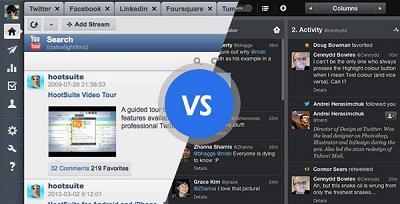Consumers interact with brands now more than ever and there is a huge player to thank: social media. On Vine, Twitter, Facebook, Pinterest, Instagram, Tumblr, YouTube and more, companies are accumulating thousands of followers and in turn, an enormous opportunity to grow their customer base and relationships.
If you’ve been in the space for quite some time now, you’ve come across two prominent names when it comes to managing social media: HootSuite and TweetDeck. HootSuite boasts users such as McDonalds and Virgin, and TweetDeck counts Yahoo and Nestle among its supporters. These dashboards help with managing different accounts, scheduling posts, analyzing metrics and more. I’ve used both, and in light of HootSuite launching its new security services, I felt it was the right time to offer a breakdown of these two platforms and hopefully help make your decision a little easier and more informed when it comes to selecting the dashboard to manage your social media.

Image via Sociable Blog
Round 1: Cost
HootSuite
HootSuite offers a free and paid version (HootSuite Pro). I’m going to jump the gun and offer a disclaimer on this battle – the free versions are pretty much a tie. It’s HootSuite’s paid version that really offers an edge over TweetDeck.
HootSuite Pro offers a lot more capabilities and features, including an unlimited number of social network accounts, Google Analytics, Facebook Insights, app directory, unlimited RSS feeds, up to two users, influence scores and the option to opt out of ads for $9.99 per month. There are even more features that can be added on for additional prices, such as vanity URLs, analytics points, archiving, HootSuite University, more users and HootCare.
TweetDeck
TweetDeck is a free Web platform. Unlike HootSuite, you can only manage different Twitter accounts in the multicolumn interface.
Round 2: Managing Multiple Accounts
HootSuite
HootSuite allows users to add Twitter, Facebook, Google+, LinkedIn, Foursquare, WordPress, MySpace and mixi accounts. (You only get to choose five accounts on the free version.) You can organize these tabs by the different accounts and then have multiple columns and streams in each. HootSuite’s free version allows users to manage up to five social profiles, customize different columns and post and schedule messages to different accounts. You can add streams by different functions based on the network.
TweetDeck
TweetDeck is purely for Twitter account management – it used to integrate Facebook accounts, but recently took away that option on May 7. You can organize the columns by timeline, interactions, mentions, followers, messages, search, lists, trends, favorites, scheduled, inbox and activity.
Round 3: User Interface
HootSuite
The difference between the interfaces on HootSuite and TweetDeck reminds me of the difference between Windows 2000 and Windows XP, and Android and iOS – they offer similar features and functions, but one is just more attractive. This is not HootSuite. At first glance, the interface can seem a little overwhelming, but is easy to manage after getting used to it. I’m not a big fan of retweeting on HootSuite either; it automatically modifies it as a RT instead of actually retweeting.
TweetDeck
TweetDeck is just cleaner than HootSuite. You can customize your dashboard by color theme (dark or light), column size (narrow, medium or wide) and font size (smallest, small, medium, large or largest). The interface combines all of your accounts into one window to scroll back and forth through (as opposed to HootSuite’s tabbed interface).
The Results
It really depends on what you’re looking for out of a social media management tool. I use TweetDeck regularly because I’m mostly monitoring Twitter for work and personal use – my Instagram, Pinterest, Facebook, LinkedIn and other accounts are all personal. For enterprises, brands and organization managers, HootSuite has a lot more to offer. Not only can you manage multiple accounts in a single location, there are so many features and capabilities offered for posting and analyzing social media campaigns. It costs a little bit of money, but with more than 58 million Americans alone utilizing social media multiple times a day, including your customers, many consider it worth the price.
Edited by
Rory J. Thompson